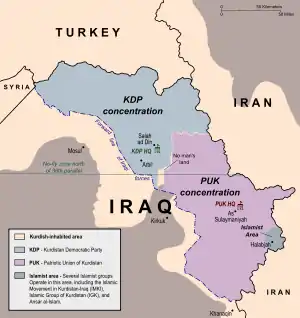Islamist insurgency in Iraqi Kurdistan
The Islamist insurgency in Iraqi Kurdistan was a military conflict in Iraqi Kurdistan between the Islamist militant group Ansar al-Islam in Kurdistan and the Kurdistan Regional Government (KRG). The conflict began in 2001, but subsequently merged with the larger 2003 invasion of Iraq. After the invasion, Ansar al-Islam continued a low-level terrorist insurgency against the KRG.
| Kurdish-Islamist Conflict | |||||||
|---|---|---|---|---|---|---|---|
| Part of The Iraqi no-fly zones conflict and the Iraq War, and War on terror | |||||||
 Iraqi Kurdistan, 2003 | |||||||
| |||||||
| Belligerents | |||||||
Supported by:
| |||||||
| Commanders and leaders | |||||||
| Strength | |||||||
| KDP and PUK: 70,000[5]~40 Americans[5]: 35 | |||||||
| Casualties and losses | |||||||
| 200+ killed[6] | Unknown, at least 45 killed and 93 wounded | ||||||
Background
Ansar al-Islam was formed in September 2001 when Jund al-Islam merged with a splinter group from the Islamic Movement of Kurdistan, under the leadership of Mullah Krekar.[3] According to the PUK, the group consisted of Kurdish veterans of Jihad who had gone to Afghanistan to fight alongside Taliban against the Soviet invasion in the 80s. They came back to Kurdistan after the defeat of the Taliban government in Afghanistan in 2001.[3] Ansar al-Islam imposed Sharia in the villages they controlled around Biyara, close to the border to Iran.
Ansar al-Islam's rule
Human Rights Watch has accused Ansar al-Islam of committing atrocities against the civilian population in the territory which they controlled. It has been alleged that Ansar al-Islam harshly persecuted the Yarsan religious minority, and enforced strict Islamic law. Human Rights Watch also accused Ansar al-Islam fighters of torturing prisoners and summarily executing captured PUK soldiers.[3] After the Battle of Kheli Hama, Ansar al-Islam were again accused of beheading and mutilating captured PUK prisoners.[7]
Assassination attempts
After two unsuccessful assassination attempts on Franso Hariri by Ansar al-Islam in Erbil in 1994 and 1997, a third attempt in 2001 on Hariri succeeded. It happened on the same exact street as the previous two attempts.[8][9]
An unsuccessful attempt was made on the life of Barham Salih in April 2002 by Ansar al-Islam. At the time, Saleh was the PUK Regional Government Prime Minister.[10] Later in February 2003 Ansar al-Islam assassinated the prominent PUK commander Shawkat Haji Mushir, along with five other people.[11]
In March 2004 the US State Department officially classified Ansar al-Islam as a terrorist organization.[12]
2003 Invasion of Iraq
During the 2003 Invasion of Iraq, US forces aided the PUK in attacking Ansar al-Islam. In late March 2003, PUK forces supported by American special forces captured Halabja after several days of heavy fighting. The surviving Ansar al-Islam forces fled to Iran.
American intelligence personnel inspected the suspected chemical weapons site in Sargat and discovered traces of Ricin in the ruins, as well as potassium chloride. They also discovered chemical weapons suits, atropine nerve gas antidotes, and manuals on manufacturing chemical weapons, lending credence to the idea that the site was related to the manufacture of chemical weapons and poisons.[2]: 320–321
After the invasion
After their defeat in Iraqi Kurdistan, Ansar al-Islam joined the Iraqi insurgency in Iraq. Several terrorist attacks in the Irbil area have been linked to Ansar al-Islam, including the Assassination of Franso Hariri, and the suicide bombing of the PUK and KDP headquarters in Irbil that killed 117 people. They also carried out the bombing of the Mount Lebanon Hotel in Baghdad on March 17, 2004.[12]
References
- "Iraqi political groupings and individuals". middleeastreference.org.uk. Archived from the original on 5 March 2007.
- Robinson, Linda (September 2005). "Chapter 13: Viking Hammer (And the Ugly Baby)" (PDF). Masters of Chaos: The Secret History of the Special Forces (New ed.). New York: PublicAffairs. pp. 296–323. ISBN 978-1-58648-352-4. [Archived]
- "Background on the Crisis in Iraq". Human Rights Watch. Human Rights Watch Backgrounder. 2 May 2003:
- "Armed Islamist groups in Iraqi Kurdistan". Human Rights Watch Backgrounder. Retrieved 20 March 2015.
- "Ansar al-Islam in Iraqi Kurdistan". Human Rights Watch Backgrounder. Retrieved 20 March 2015.
- Pike, John (30 April 2004), Steven Aftergood (ed.), "Ansar al-Islam", FAS–IRP Intelligence Resource Program Archive, Federation of American Scientists, retrieved 20 March 2015
- Peltier, Isaac J. (26 May 2005), Surrogate Warfare: The Role of U.S. Army Special Forces, Fort Leavenworth, Kansas: U.S. Army School of Advanced Military Studies, United States Army Command and General Staff College, [Monograph] – via Defense Technical Information Center. PDF link. Archived 11 February 2009 at the Wayback Machine
- Pike, John (n.d.). "Iraqi Insurgency Groups". GlobalSecurity.org.
- Amnesty International Report 2002 – Iraq, Amnesty International, 28 May 2002, (Covering events from January–December 2001), retrieved 2023-02-20 – via Refworld
- "Franso Hariri, 1937–2001 — biography". eKurds (in Kurdish, Arabic, and English). n.d. Archived from the original on 12 October 2022.
- Assyrian National News (19 February 2001). "Assassination of Franso Hariri, a Member of Kurdish Leadership" (Press release). Atour: The State of Assyria for Atourayeh. Kurdish Media; Assyrian Information Management (AIM). Archived from the original on 6 April 2001.
- "Terrorist Organization Profiles: Ansar Al-Islam, Iraq". BAAD – Big, Allied and Dangerous database. National Consortium for the Study of Terrorism and Response to Terrorism – START.umd.edu. 2012 [Last updated, April 2015]. Archived from the original on 9 September 2023. Retrieved 20 March 2015.
- Muir, Jim (9 February 2003). "Gunmen kill Iraqi Kurdish leader". BBC News. Retrieved 20 March 2015.
- Pike, John (n.d.). "Ansar al Islam (Supporters of Islam)". GlobalSecurity.org. Retrieved 20 March 2015.